“If I can't make it through one door, I'll go through another door - or I'll make a door. Something terrific will come no matter how dark the present.” -Rabindranath Tagore
Time continues marching on here at Starts With A Bang, just as it does everywhere. My Patreon supporters have stepped up their game, and we're just $21 shy of unlocking our next goal! There are two great new items this week I'd love to share with you: first, our newest Podcast on dark energy and the fate of the Universe,
- How does dark matter interact with black holes? (for Ask Ethan),
- Hubble unveils deepest view of the Universe ever (for Mostly Mute Monday),
- What are the odds of finding Earth 2.0?,
- Which elements will never be made by our Sun?,
- The limits of how far humanity can go in the Universe, and
- Could a new type of supernova eliminate the need for dark energy?
For those of you in Washington State, head on over to Centralia College on May 20th at noon, where I'll be speaking on Fate of the Universe. (And autographing books, too!) Now let's jump on in to the best of the second week in May, and dive into our Comments Of The Week!
From Apeon LastnmUnk on the concept of settled science: "Your description of science as continually seeking, and never being absolute, refutes the “Settled Science” of Global Warming."
By that logic, the attributes of continually seeking and never being absolute would refute any scientific conclusions one would ever make. See if you can follow this train:
- Science accumulates large amounts of data through experiment, measurement and observation: a suite of evidence.
- In that suite of evidence are uncertainties: uncertainties in the measurements/observations themselves and uncertainties about what results other experiments-not-performed and observations-not-made would yield.
- And then, to explain it all, we have scientific theories that are valid over a certain range, with a certain degree of confidence we can express.
The Global Warming theory -- that the Earth is warming and that human-caused changes to the atmosphere is the culprit -- has been quantified to be valid at approximately 4.8-sigma statistical significance: to a 99.999%+ probability. Yes, there are more things to understand about it, but my description is not a refutation, unless you're being completely dishonest about what science is and isn't.
Image credit: Rutgers, retrieved from http://www.physics.rutgers.edu/~zrwan/physics/.
From Sinisa Lazarek on the Stern-Gerlach experiments: "Concerning entanglement: “So what if you took the ones you measured to be +ħ/2 in the x-direction, then measured the y-direction …. ”
Because you simply CAN’T do that in real life. Once you made ONE measurement, that’s it… game over. No more entangled pair.
You can entangle them again, but this is a completely new [measurement], absolutely unconnected to the one you did before, in all practical sense.. they are new particle pairs."
I think there has been a misunderstanding here. The Stern-Gerlach experiment isn't about entanglement, it's about quantum indeterminism and the nature of quantum systems. If you have a spin-ħ/2 particle, it will have a spin along the x-axis that's either +ħ/2 or -ħ/2, right? Same with the y-axis and the z-axis. It's all in an indeterminate state, until you measure it.
Yet if you measure the spin in the x-direction and get, say, +ħ/2, you destroy all the information about the y-axis and z-axis directions. They now have 50/50 shots of being +ħ/2 and -ħ/2. If you then measure the y-axis spin and get -ħ/2, the x-direction is now re-randomized, and has a 50/50 shot of being +ħ/2 and -ħ/2. That's the point of Stern-Gerlach; nothing to do with entanglement.
From See Noevo on flippancy: "Welcome to the SciFi Channel."
Here's a quote for you that I think applies: "Don’t waste your time trying to explain yourself to people that are committed to misunderstanding you." You clearly have all the answers you want or need, so there's no need for me to provide anything further to you, right?
The giant elliptical galaxy, M87, and its 5,000+ light year-long jet, highly collimated, as imaged by the Hubble Space Telescope. Image credit: NASA and The Hubble Heritage Team (STScI/AURA).
From Denier on black hole jets and their cause: "How is the inability to discern the electric charge of the matter that makes up a black hole reconciled with the jets emanating from the poles of feeding black holes? As I understand the theory, the particles in the jets are accelerated by the magnetic field of the black hole. The magnetic field should vary with the make-up of the black hole, no?"
This is actually a hotly debated topic! There certainly are magnetic fields accelerating charged particles here, and that's what causes the jets. But are these magnetic fields:
- Relics of the magnetic fields that existed in the stellar core/neutron star that existed before a black hole formed, remaining due to a process like flux pinning?
- A fundamental property of a charged black hole that's rotating?
- Due to electric currents from outside the black hole's event horizon, due to the accretion disk or other matter outside it?
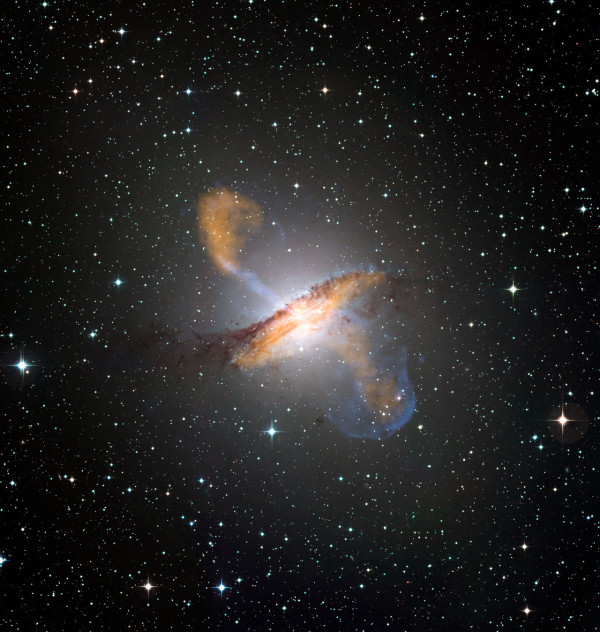 Image credit: ESO/WFI (visible); MPIfR/ESO/APEX/A.Weiss et al. (microwave); NASA/CXC/CfA/R.Kraft et al. (X-ray).
Image credit: ESO/WFI (visible); MPIfR/ESO/APEX/A.Weiss et al. (microwave); NASA/CXC/CfA/R.Kraft et al. (X-ray).
Of these three options, number 2 is the least favored explanation, as a galaxy like Centaurus A (above) has only a 55 million solar mass black hole; just 13 times as massive as our own. It's unlikely that such a large electric charge differential will exist in the black hole; what would segregate billions of Coulombs' worth of charge, keeping ~10^30 extra charges of one type inside the black hole while expelling that amount outside of it? The numbers seem too great to be explained by that possibility, but we have been surprised before.
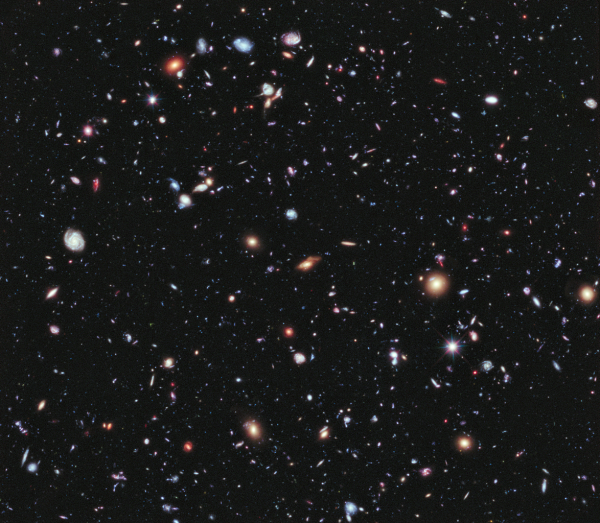 The Hubble eXtreme Deep Field (XDF), which revealed approximately 50% more galaxies-per-square-degree than the previous Ultra-Deep Field. Image credit: NASA; ESA; G. Illingworth, D. Magee, and P. Oesch, University of California, Santa Cruz; R. Bouwens, Leiden University; and the HUDF09 Team.
The Hubble eXtreme Deep Field (XDF), which revealed approximately 50% more galaxies-per-square-degree than the previous Ultra-Deep Field. Image credit: NASA; ESA; G. Illingworth, D. Magee, and P. Oesch, University of California, Santa Cruz; R. Bouwens, Leiden University; and the HUDF09 Team.
From Naked Bunny with a Whip on the vastness of the Hubble eXtreme Deep Field: "Photos like this make me glad I’m so ill-equipped to fathom the vastness on display. I think it’d be overwhelming if I could even approach it."
Personally, I can't wait for the James Webb Space Telescope to push these limits back even farther. Is 170 billion galaxies in the observable Universe the right number? Certainly not; it's surely too low. But by how much? Is the number more like 300 billion? 1 trillion? 100 trillion? And where is the cutoff for what we consider a galaxy: 1% the mass of our Milky Way? 0.1%? 0.001%?
These are questions that we'll actually have quantifiable answers to over the next generation. It may bend your mind, but it should bend your mind!
 The exoplanet Kepler-452b (R), as compared with Earth (L), a possible candidate for Earth 2.0. Image credit: Image credit: NASA/Ames/JPL-Caltech/T. Pyle.
The exoplanet Kepler-452b (R), as compared with Earth (L), a possible candidate for Earth 2.0. Image credit: Image credit: NASA/Ames/JPL-Caltech/T. Pyle.
From eric on the exoplanet problem: "This seems a big step to me. AIUI our atmosphere is a result of the particular evolutionary pathway that life took on Earth. Specifically, we have an oxygen rich atmosphere with few sulfides, carbonates, nitrides, etc. because (we think) the earliest forms of life ate the latter and pumped out oxygen as a waste product. If Gould is right and rewinding the tape of life couldn’t be expected to lead to a similar end-state, then there is very little reason to believe that a different rocky planet in a habitable zone with life would develop atmospheric conditions similar to ours."
It is a big step, but I don't think it's necessarily as big a step as you fear. It's a question of biochemistry, but a relatively simple one: if you're living in a methane-rich (carbon), ammonia-rich (nitrogen), and water-rich environment (oxygen), what are the good, possible pathways to construct molecules that allow you to gather, store, and harness energy? It turns out a considerable number of successful pathways result in the production of molecular oxygen as a waste product, and hence would severely enrich the atmosphere.
You don't need a similar end-state to get some similar generic properties, and an oxygen-rich atmosphere may be one of those properties. We're not sure, as it's pretty hard to extrapolate probabilities from an N=1 sample size, but certainly examining habitable-zone exoatmospheres will teach us a lot about what's out there!
From Sinisa Lazarek on an objection to 60 billion habitable-zone super-Earth-or-smaller planets in our galaxy: "If of the 150.000 sampled stars, we found 2.000 exoplanets, of which 40% are rocky… that would mean (to round it).. 1000 rocky planets for 150.000 stars, or in other words.. a little less then 1% of the numbers of stars. How can then we have 60 billion estimated habitable worlds in our galaxy, if our galaxy has 100 billion stars. By math above, we should less then 1 billion rocky worlds.. of which some would be in habitable zone. In other words.. in millions.. but not in billions. One order of magnitude lower.
I’m either missing something important, or there’s a mistake somewhere in numbers."
Which is a good objection; you should be able to run the math for yourself. But this was answered in spirit very well by Denier: "Kepler is finding exoplanets via the transit method which means the orbital plane of the solar system has to be inline enough for Kepler’s cameras to see the planet cross the face of the star. Your back-of-the-napkin calculations left out the odds of that alignment."
The odds of a good alignment are significantly higher for very close-in planets, and are actually <1% by time you get out to a star's habitable zone. So that accounts for more than two orders of magnitude in your back-of-the-napkin calculation, and the fact that our galaxy has more like 400 billion stars than 100 billion and that finding inner planets likely means there are many more, outer planets greatly changes the estimates.
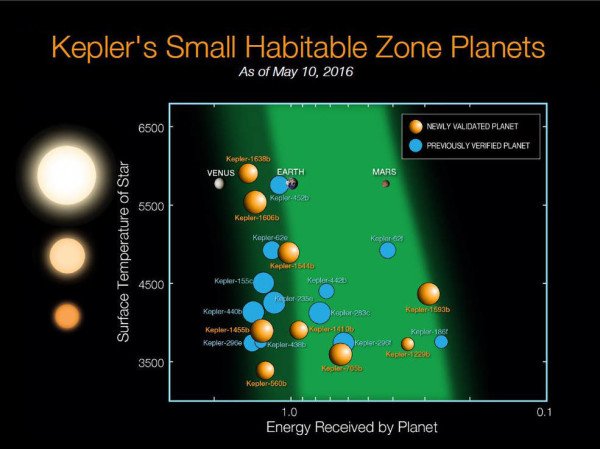 The 21 Kepler planets discovered in the habitable zones of their stars, no larger than twice the Earth's diameter. Image credit: NASA Ames/N. Batalha and W. Stenzel.
The 21 Kepler planets discovered in the habitable zones of their stars, no larger than twice the Earth's diameter. Image credit: NASA Ames/N. Batalha and W. Stenzel.
From Denier on tidal locking and what that means for exo-life: "A big concern, and something I didn’t see addressed in the article was tidal locking. Even if you do get a planet the right size, made from the right stuff, and the correct distance from the star to support liquid water on the surface, if it is tidally locked it is not going to be Earth 2.0."
First off, I should clarify that "Earth 2.0" doesn't necessarily mean a planet exactly like Earth, but rather one that has complex life on its surface and that also isn't totally inhospitable to humans. This could, however, look very different than Earth does. Yes, it's true that most rocky planets the size of Earth or smaller in the habitable zone of an M-dwarf would probably be locked after ~5 billion years, a calculation you can do yourself.
But that doesn't mean:
- You can't have life thriving in a "ring" on the border between night and day.
- You can't have a strong atmosphere that transports heat and energy evenly around the planet (Venus does, for instance).
- Or you can't have "day side" life that thrives that simply looks different from the life we know.
It might not look like Earth 1.0, but it might still be a great Earth 2.0 candidate.
From Michael Kelsey on supernova nucleosynthesis: "Theoretically, how confident are you that the r-process (i.e. single neutron capture) can really produce trans-plutonian elements? Most of the decay channels for those (man-made) elements are alpha decays, not betas. I couldn’t find (in my cursory search) papers to support your statement; any chance you can point me to a decent review?"
First off, let me be very clear about three facts:
- This is an active field of research where theoretical developments are far ahead of observational constraints.
- It is also not my primary field of study; I know about it tangentially, not from my own research.
- But there are good theoretical reasons why there should be some r-process production, even though the greatest abundance of these trans-uranic (or trans-plutonic, which I think is the right word) elements should be created in neutron-star mergers.
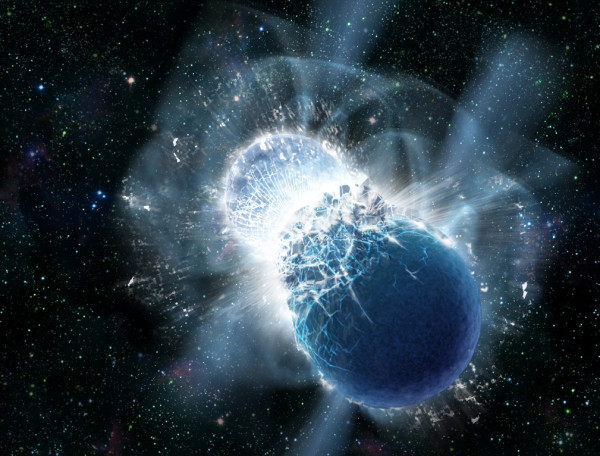 Two neutron stars colliding, which is the primary source of many of the heaviest periodic table elements in the Universe. Image credit: Dana Berry, SkyWorks Digital, Inc.
Two neutron stars colliding, which is the primary source of many of the heaviest periodic table elements in the Universe. Image credit: Dana Berry, SkyWorks Digital, Inc.
The expectation is that the supernova neutron flux -- which is intense, at ~10^22 neutrons/cm^2/s -- should result in neutron capture rates of ~1 neutron-per-minute, give or take. Now, supernovae are fast processes, but neutrons stick around for some time, and there's going to be a probability distribution function that gives non-zero realizations, in a typical supernova, for the capture of up to ~20-30 neutrons by an initial (let's say) uranium nucleus. Get up to U-239, U-241 or U-242 and you make neptunium in minutes, which makes plutonium in minutes as well. There is some considerable evidence that primordial Pu-244 exists on Earth.
If you make either Pu-243 or Pu-245 or higher, it beta decays as well, creating Americium, almost all of which -- at those masses -- will beta decay into curium, which has some isotopes that are quite stable! Cm-247 lives for ~16 million years on average, which isn't enough that any of it is found on Earth, but perhaps there was some when life first arose on our planet. By looking at half-lives and preferred decay pathways, neutron capture should be able to get you all the way up the actinide chain and even into elements like 104-through-106, although probably not further than that. You asked for some reviews, and I don't know that this will sate you, but here are a few papers you might consider if you're interested in further reading:
- Frontiers in Nuclear Astrophysics by Carlos A. Bertulani and Toshitaka Kajino (a nice review),
- Solar r-process-constrained actinide production in neutrino-driven winds of supernovae by S. Goriely and H.-Th. Janka,
- and some observational constraints and what they mean can be found in New limit of 244Pu on Earth points to rarity of actinide nucleosynthesis by A. Wallner et al. and Short-lived 244Pu Points to Compact Binary Mergers as Sites for Heavy r-process Nucleosynthesis by Kenta Hotokezaka, Tsvi Piran and Michael Paul.
There is a good discussion of some of these points further down in the comment thread from Michael and eric, but I wanted to weigh in for everyone to follow, too.
From rev on some Forbes-and-Ethan bashing: "@Ethan: Still on forbes? I don’t understand. Something is rotten in the state of Science."
They pay me to write for them. If you'd rather pay me instead, perhaps I'll write where you choose?
From Claud Owens on the edge of the Universe: "Let us say that we finally reach the outer limit of the universe. What should we call that on the other side of the limit?"
First off, you can't, not unless you poke a hole in the fabric of spacetime and come out in a special-relativity-violating location. The limits of what we can reach are about 1/3 of the way to the edge of the visible Universe. If you could magically transport yourself -- via wormhole or somesuch method -- to the outer limit of the observable Universe, you'd simply find more Universe that was like our own on large scales and different in detail on small ones. You'd call it "Universe", but to someone who couldn't see it, we might (depending on our definitions) call it part of the multiverse.
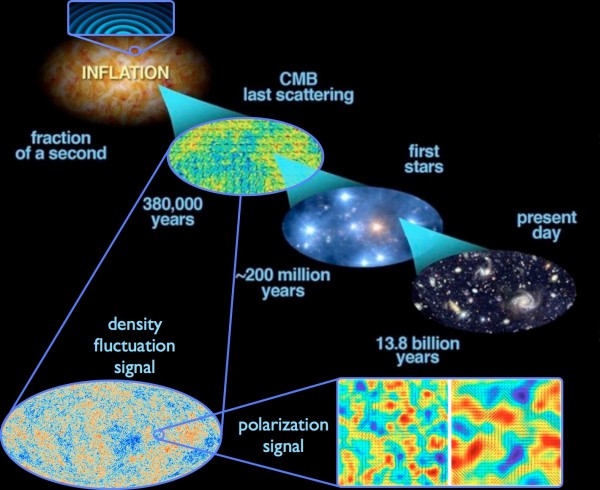 Fluctuations in spacetime itself at the quantum scale get stretched across the Universe during inflation, giving rise to imperfections in both density and gravitational waves. Image credit: E. Siegel, with images derived from ESA/Planck and the DoE/NASA/ NSF interagency task force on CMB research.
Fluctuations in spacetime itself at the quantum scale get stretched across the Universe during inflation, giving rise to imperfections in both density and gravitational waves. Image credit: E. Siegel, with images derived from ESA/Planck and the DoE/NASA/ NSF interagency task force on CMB research.
From Jose Pacheco on the Hot Big Bang: "The Big Bang Theory doesn’t say the universe came from nothing. It says that if we rewind the universe to a point about 13.8 billion years ago, the entirety of the universe was very close together. There is a point though, where current physics break down, and we don’t know what came before."
This is very good, although we have some very, very strong evidence that cosmological inflation came before you reach the breakdown point. You can read about cosmic inflation's six predictions, five of which have been verified. (That's pretty good!)
 A Type Ia supernova in the nearby galaxy M82. This one is fundamentally different from the one atop this page, observed in 2011 in M101. Image credit: NASA/Swift/P. Brown, TAMU.
A Type Ia supernova in the nearby galaxy M82. This one is fundamentally different from the one atop this page, observed in 2011 in M101. Image credit: NASA/Swift/P. Brown, TAMU.
And finally, from Michael Richmond on the supernova/dark energy conundrum: "Ethan, could you please provide references for statements like “a 2015 study put forth a possibility that many scientists dreaded?” I read the article on Forbes, and I couldn’t find the reference there, either."
Although EpiPete provided the links in a comment and the "a 2015 study showed another possibility" actually links to the press release from the Forbes article to the U. of A. piece, I thought I'd take the opportunity to discuss what the difference between the supernovae are and why it doesn't wreck the accelerating Universe. What Peter A. Milne's study found is that there are actually two classes of type Ia supernovae: some are "bluer" and some are "redder". The bluer type are the minority nearby, where most of them are red, but are the majority type at great cosmic distances, where fewer are red. Therefore, there's a bit of a bias to the data. However, as Milne says:
"To be clear, this research does not suggest that there is no acceleration, just that there might be less of it."
You will notice that earlier dark energy reports had ~72-76% of the Universe's energy in the form of dark energy, while more recent ones have it at ~66-68%. The Universe is still accelerating, dark energy is still a cosmological constant, and it's still dominating the energy density of the Universe. There's just a few percent less of it than we thought!
Have a great week, and thanks for all your support! See you back tomorrow for even more of the Universe!



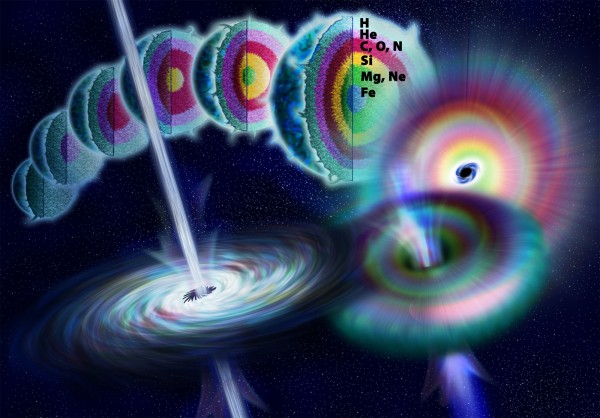


Jose Pacheco on the Hot Big Bang: “The Big Bang Theory doesn’t say the universe came from nothing. It says that if we rewind the universe to a point about 13.8 billion years ago, the entirety of the universe was very close together. There is a point though, where current physics break down, and we don’t know what came before.”
Ethan responds: “This is very good…”
However, what’s NOT so good, is that although the Big Bangers claim they can rewind the universe to a *precise time* 13.8 billion years ago and to an *extremely small* point,
they claim they don’t know or can’t know *where* that long ago teeny place was.
So, regarding the universe’s starting point, Ethan and the cosmo guys tell us how long ago it was,
and how small it was …
but not *where* it was.
Ethan wrote about Alan Guth recently. I think Alan's considered a/the father of cosmo inflation.
Alan won $3 million for proposing that the early universe inflated from a point of singularity to become the size of a marble.
Marbles have centers.
WHERE is the center of the universe?
Can you at least point the way, Ethan?
That doesn't get us much closer. In order for a reasonably similar atmosphere you have to assume oxygen-using organisms don't co-evolve over the first billion years, allowing the anerobic life to change the atmosphere and make it unlivable for themselves in the process...and then aerobic oxygen-using organisms must evolve, along with carbonate-using aerobic organisms, and that all these organisms reach the same equilibrium point.
I just don't see it as at all likely. Microscopic life? Okay. Life that leads to atmosphere that has similar components at similar temperatures and pressures? Highly unlikely (IMO).
To eric,
Speaking of an oxygen rich atmosphere, and pathways to it, do you hold to the hypothesis that photosynthesis evolved over time?
If you do, then, as you asked of me on another subject:
Okay, how would we test that hypothesis? What future data collection would confirm or disconfirm it?
P.S.
I’m not sure if this piece gives a step-by-step pathway to photosynthesis. I confess I haven’t read it all. It’s over 40 clicks long.
https://en.wikipedia.org/wiki/Photosynthesis
From Apeon LastnmUnk on the concept of settled science: “Your description of science as continually seeking, and never being absolute, refutes the “Settled Science” of Global Warming.”
By that logic, the attributes of continually seeking and never being absolute would refute any scientific conclusions one would ever make. See if you can follow this train:
Please!----I was making reference to the claim of GlobalWarmist s that the Science is "Settled" as in--Never question us again.
There is, I believe French. group that has predicted a 'mini-ice age' about 2030-----hope to make it there to see it, if they are correct, and to see the justifications by the Global Warmists.
I have no problem with Science, and Scientific Conclusions, but when the UN is purely political in nature, I have a strong suspicion, and revert to Feynman.
If it evolved over time then we'd expect to find a pattern of descent with modification for adaptations allowing for the use of sunlight. <a href="http://www.plantphysiol.org/content/154/2/434.full"And we have..
Wow, that took me all of 10 seconds. Type "evolution of photosynthesis" into google, scroll past the wikipedia entry, and you could have educated yourself about the evidence for the evolution of photosynthesis. There are none so blind as those who will not see.
On the Global Warming discussion----I am convinced that the Earth is warming----in my short life, I remember much snowier, colder winters until I graduated in 1961, when it became warmer.
I also remember more recently the 'discovery' of numerous methane vents on the Atlantic coast, but no one seems to have evaluated there possible effect on warming, and more recently the change in scientific thought that the convection of molten material in the mantle is much faster than previously considered, and its effect on ocean temperature, and consequently global warming. So much we do not know, to make such catastrophic predictions re: the consequences. In these matters, we do NOt know what we do NOT know.
Did you miss this part?
"You clearly have all the answers you want or need, so there’s no need for me to provide anything further to you, right?"
Given that S.N. is just pathetically, thoughtlessly repeating itself (which is quite a waste of G-d's greatest creation) at this point, I'm going with letting it wither.
To eric #5:
“If [photosynthesis] evolved over time then we’d expect to find a pattern of descent with modification for adaptations allowing for the use of sunlight. <a href="http://www.plantphysiol.org/content/154/2/434.full"And we have... you could have educated yourself about the evidence for the evolution of photosynthesis.”
I’m not certain, but I *think* I had read that piece from Plant Physiology in the past.
And it contributed to my abandonment of belief in evolution.
It does have some remarkable words and passages, such as
“… has evolved via a complex path…
“no apparent pattern of evolution…
“no one simple branching diagram can accurately represent the evolution of photosynthesis…
“promises to permit substantially more progress in unraveling this complex evolutionary process…
“the evolution of photosynthetic pigments, reaction centers (RCs), light-harvesting (LH) antenna systems, electron transport pathways, and carbon fixation pathways…
“We know very little about the earliest origins of photosynthesis.
“There have been numerous suggestions as to where and how the process originated, but there is no direct evidence to support any of the possible origins..
“All of these claims for early photosynthesis are highly controversial…”
……………..
Remarkable. Incredible.
"From rev on some Forbes-and-Ethan bashing: “@Ethan: Still on forbes? I don’t understand. Something is rotten in the state of Science.”
They pay me to write for them. If you’d rather pay me instead, perhaps I’ll write where you choose?"
Beautiful!!! I Love it. Capitalism at it's finest.
Ethan sells his product on the free marketplace of ideas and all parties benefit.
Thanks Ethan, You AND Forbes ROCK!!!
Go Trump!!
Please, YOU MADE THAT UP.
"I also remember more recently the ‘discovery’ of numerous methane vents on the Atlantic coast, but no one seems to have evaluated there possible effect on warming"
And you didn't look.
How much do those vents give out? Checked? At all? go on, do that. Let us know.
Go trump! Go and take an intelligence test.
And then we can laugh all our arses off as you flunk badly.
Wow #12:
Speaking of...
http://www.usatoday.com/story/news/politics/onpolitics/2016/05/16/trump…
"Go and take an intelligence test"
Go and take a look at the muzzies overtaking your country retard.
Wowzer, on the brightside here, all your Christian bashing sowing is reaping you muzzie Rule so be thinking about what you wished for when your fagoty ass is being tossed off a 10 story building and then stoned after ya hit bottom when your new rulers take full command. LOL
I spose on the way down before hitting the ground you may have a flash thought think... "That Teabag bloke may have had a point" But spose it's to late now...........splat
Bwah_haha_hahaaaa
If england were being overtaken by terrorists you might have a point rag, but they aren't: it is simply your ignorance, racism, and bigotry speaking, as usual.
The sad thing is that we have a candidate on the right that is collecting the absolute worst people in this country as supporters: low-lifes, white supremacists, racists of all sorts, people with no understanding of how the government and economy work - purely vile people.
QM is Cloud Cuckoo Land. I found this page that illustrates what you are saying, but the concept doesn't make any sense:
When dealing with a particle that was determined to be +ħ/2 by an SGA, you know a second successive SGA test will confirm you are dealing with +ħ/2 unless that second SGA is rotated 90 degrees in which case it is anyone's guess what you've got even though it was just proven to be +ħ/2. And it works that way because, you know, Quantum Mechanics.
@Denier #17: Your last paragraph has it exactly right! What you're missing is that the "signed" spin IS NOT A SCALAR! It's a shorthand (and for non-physicists a misleading shorthand) for one component of a vector. Here's the deal, written out in vector notation, where X = (1,0,0), Y = (0,1,0), and Z = (0,0,1) are the normal Cartesian unit vectors.
So an electron has half integer spin. That means its total spin J = ħ/2 (or just 1/2 in convenient units of ħ = 1). That J is a scalar quantity, the magnitude (length) of a vector.
Suppose you throw an electron through a spinmeter (a Stern-Gerlach device, or something equivalent). You have to configure that device to measure along some particular axis, usually either X or Y (taking Z to be the beam direction), but it could be at 45 degrees [i.e., (X+Y)/sqrt(2)]. Let's say you choose to set up your spinmeter to measure along Y. We _know_ the electron has J=1/2 (magnitude), so your measurement will be a _vector_, either (1/2)Y or (-1/2)Y. Let's assume that you get a result of (1/2)Y, so we know the electron's spin is _oriented_ to point along the +Y axis.
Supposed you now pass that same electron through a second spinmeter oriented along Y again. In that case, you will get EXACTLY THE SAME RESULT, (+1/2)Y direction, as you just got above. In fact, you can stack up as many of these spinmeters as you like, and so long as they're all oriented parallel to one another, all your electron direction measurements will match the first one.
But now, take that same electron, and put it through yet another spinmeter oriented along the X axis. You just measured (projected, in QM terminology), the electron to have its spin _vector_ pointed along +Y, so coming into the apparatus, its spin vector is perpendicular to X, and doesn't have a component along that direction.
But you *CANNOT* measure zero for the electron! It has spin 1/2, period. You have to get a measurement with a magnitude of 1/2, and since your apparatus is oriented along X, you must get a vector measurement of _either_ (+1/2)X or (-1/2)X. This is a new project, orthogonal to the previous one, and so your measurement has a 50-50 chance of being either of those values.
The important thing for you to take away here, is that the measurement is a vector, not a scalar. In addition to the +1/2 or -1/2 value, you *MUST* include the direction (axis) of the measurement.
@Michael Kelsey #18
Thanks. That helps a lot. I think I have a loose grasp on it.
Spin is not a Scalar. It is less than a scalar because a scalar or vector component has a dimension. The X dimension runs right and left. The Y dimension runs up and down. The Z dimension runs in and out. Spin cannot run up and down like X, but it can be aligned to run up or down, or left or right, or in or out. Spin is information only complete enough to represent half of a dimension, and that magnitude (length) can be oriented to the X, Y, or Z axis.
When spin is determined to be +ħ/2 in X, then it doesn't exist at all in Y or Z, or even the down half of X. If realigned to another axis spin can orient to the new axis but when it does then it will no longer exist in X. Its magnitude/length will manifest in half of whatever the new axis is only.
The up or down of the spin exhibits equally because vector information doesn't belong to spin. The universe fills in the direction to meet the minimum requirements to exist and because the universe doesn't have a bias the spin shows as up axis or down axis equally, but the information contained in the spin is really only the magnitude.
If I understand correctly then should be impossible to entangle 3 or more particles of any kind, and it should also be impossible to entangle even a pair of spin-0 particles.
@Denier #19: I would highly recommend reading some proper articles on the subject of quantum mechanical spin, including Wikipedia.
Spin is PRECISELY a vector quantity. It is angular momentum. Nothing more, and nothing less. It is, in particular, the intrinsic angular momentum a particle has by its very nature, without any reference to motion about an external point (the latter is called "orbital angular momentum").
The non-commuting properties of the components of spin are what make it quantum mechanical. Your description above is trying to apply macroscopic, classical ideas, which is simply wrong.
Wow-----Too bad you are unable to respectfully respond-----lack of respect is a strong indicator of a weak argument----In fact I have searched for conclusions re: seepage, and there is no 'Settled Science" about it, as conclusions are based on conjecture. But of course I am sure that you can continue in your obviously superior manner.
WOW----obviously you did laugh your arse off----but when you put it back on you covered your nose.
The W—ia entry on multipartite entanglement might be less than helpful, but this Stack Exchange item is pretty approachable.
Here’s a circle song…for the cosmic spin doctors here:
https://www.youtube.com/watch?v=d0ZljYnObOI
And if anyone is wondering why physicists give quark properties the names up, down, strange, charm, and color (in addition to spin), AIUI this is part of the reason why. Because after watching students confuse QM spin with classical spin, they didn't want to name the other QM subatomic properties after classical physics labels for properties that might share the same units, and risk students confusing the two.
@eric #25
I'm responsible for the naming of the quarks? HOW AWESOME IS THAT!!!!!! I'm feeling very important. Is there anything else on which Physicists need proper motivation that I can help with? :)
"Go and take a look at the muzzies overtaking your country retard."
Go and take a look at Fox's retraction of their piece as completely fabricated, fuckwit.
"I’m responsible for the naming of the quarks? "
No, stupidity like yours is responsible for the naming of the quarks.
This is not amazing, this is shameful.
At least for any decent human being.
YMMV.
@Wow #29
You mean the naming of quarks wasn't my doing? Boy do I feel silly. I'm glad you were here to explain it. That could have been really embarrassing.
No, the naming of quarks wasn't your doing.
It does sadden me that it appeared you needed to be told that and I hope that having your stupidity pointed out was at least useful in its embarrassment of you, but it looks like you've saddled up more idiocy to create a solpistic armour to protect you from embarrassment. Unfortunately it will also armour you against any improvement on your current parlous state of ill education.
Wow
May 20, 2016
Wow—–Too bad you are unable to respectfully respond
Why? Your idiotic rantings did not deserve one iota of respect. If you can’t handle that, then I’m sorry that you are so weak willed and unwilling to do some honest thinking.---ALL ARE DUE RESPECT.
lack of respect is a strong indicator of a weak argument
Nope, it’s a strong indicator that there is no respect.THE 'QUALITY' IS NOT THE INDICATOR OF ITSELF--VERY UNSCIENTIFIC
You have to EARN respect, kid. Don’t just squeal and demand it.--YOUR SQUEALING CONFIRMS THIS ARGUMENT
and there is no ‘Settled Science” about it,
No, there’s plenty of settle science about it.
Thermodynamics.
Stephan’s Law
Radiative physics
Molecular physics
Chemistry (burning of hydrocarbons in an oxygenated atmosphere).THESE ARE 'SYSTEMS OF PHYSICS' WHICH NEED TO BE APPLIED TO THE QUESTION---THEY ARE NOT A REFUTATION OF ANYTHING IN AND OF THEMSELVES
There’s nothing “settled” because you’re in denial, kid.
“as conclusions are based on conjecture.”
Nope, conclusions are based on conjecture (if we don’t stop…) AND solid settle physical science.THE CONCLUSIONS I REFERRED TO WERE THE CONCLUSIONS REGARDING THE EFFECT OF METHANE PLUMES ON GLOBAL WARMING----AND THE CONCLUSIONS EXPRESSED BY THOSE REPORTING WERE BASED ON CONJECTURE, AS THEY DO NOT YET UNDERSTAND HOW IT WORKS
You’re just in deep and dishonest denial of reality.
YOUR LANGUAGE PROVES YOUR LACK OF RESPECT FOR OTHERS, AS MANY OF YOUR OTHER POSTS ARE ON THE BOTTOM OF THE HEIRARCHY IN 'COMMENT STANDARDS'
I PRESENT THE ARGUMENTS AND FACTS AS I UNDERSTAND THEM--RESPECTFULLY---BUT YOU DO NOT INFORM, ADVISE, OR EXPLAIN----YOU ATTACK!
You have been warned---take you commenting to "The Page"
Liar.
This is not respectful, it is not factual, and it is not an argument. It is an insulting strawman. At least Wow had the decency to direct his comments directly to you. You slime thousands of scientists by misrepresenting their work and their motivations with insinuation and incoherent JAQing off.
LOL. What arrogance.
To Ethan:
•Science accumulates large amounts of data through experiment, measurement and observation: a suite of evidence.
•In that suite of evidence are uncertainties: uncertainties in the measurements/observations themselves and uncertainties about what results other experiments-not-performed and observations-not-made would yield.
•And then, to explain it all, we have scientific theories that are valid over a certain range, with a certain degree of confidence we can express.---Agreed
The Global Warming theory — that the Earth is warming and that human-caused changes to the atmosphere is the culprit — has been quantified to be valid at approximately 4.8-sigma statistical significance: to a 99.999%+ probability. Yes, there are more things to understand about it, but my description is not a refutation, unless you’re being completely dishonest about what science is and isn’t---The 'posit' that I must be dis-honest if I do not agree with you is chilling not only to conversation, but also makes it difficult to arrive at the truth------All of this would have been as valid re: Newtonian physics in 1904, as it is valid to Global Warming today----The Global Warmists will accept nothing else, much as the Newtonians would NOT accept Einsteins work.
Also---ALL influences on Climate are NOT known----many are, and just perhaps many more will be discovered. I do not know, and neither does anyone else. Perhaps factors in the the earth's development were setting the stage for 'warming' and man's contribution merely moved it forward 50 or a 100 years.
how we treat each other.
This is leading to my point---"how we treat each other. On this blog, that means with our words to one another."
I have no complaint to your initial reply to me, as the point I was attempting was not adequately made. However, 'Wow', and 'Bunny with a whip' are certainly not responding as your statements in the the commenting guidelines indicate you would like. They are obviously well beyond me in understanding physics as I have read some of their other posts. Still, their expressed attitude towards those who disagree, are well in line with the statement I made re: 'Settled Science' which brooks NO departure. It is 'Political Correctness' in the scientific realm. 'Scientific Correctness', an oxymoron. There is discussion among scientific persons to criminalize those who disagree. Maybe they should headquarter in Salem, Mass.
Banning me from this blog would not hurt my feelings, I have been banned from some churches too.
"ALL ARE DUE RESPECT."
AND I GAVE THEM ALL THE RESPECT OWED THEM!
FUCK ALL!
"THE CONCLUSIONS I REFERRED TO WERE THE CONCLUSIONS REGARDING THE EFFECT OF METHANE PLUMES ON GLOBAL WARMING"
So who the fuck is calling that "settled science"you moronic knuckle-dragging retard?
"ALL influences on Climate are NOT known"
They DON'T HAVE TO BE.
No, you are misrepresenting their comments. Your continued statement that the science community is yelling "Never question us again" is a line of horse crap, and that was pointed out.
And this
is the grossest misrepresentation of an idea seen here in a long time (well, almost the grossest: sn's continual habitual lies about science have that locked up). You truly deserved to be called on that.
WOW, DEAN, & BUNNY WHIP
https://wattsupwiththat.com/2016/05/27/surprise-finding-arctic-ocean-me…
NOTE THE DATE
"No, you are misrepresenting their comments. Your continued statement that the science community is yelling “Never question us again” is a line of horse crap, and that was pointed out."
YOU are misrepresenting my comment----my comment referred to those in the scientific community who are indeed wanting to criminalize dissent, and those who advocate "Settled Science" re: AGW, do indeed do so---apparently you are not aware of all that is happening.
You are also apparently unaware of your own 'intolerant' attitude, and hatefilled reaction toward those who disagree with you.
@40: watts' website is a hangout for kooks and deniers. No science is done there.
"my comment referred to those in the scientific community who are indeed wanting to criminalize dissent,"
Nobody is doing that. You are intentionally misrepresenting facts.
"those who advocate “Settled Science” "
You clearly do not understand the meaning of "settled science."